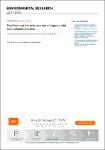Peat fires and the unknown risk of legacy metal and metalloid pollution
| dc.contributor.author | McCarter, CPR | |
| dc.contributor.author | Clay, GD | |
| dc.contributor.author | Wilkinson, SL | |
| dc.contributor.author | Page, S | |
| dc.contributor.author | Shuttleworth, EL | |
| dc.contributor.author | Davidson, SJ | |
| dc.contributor.author | Taufik, M | |
| dc.contributor.author | Sigmund, G | |
| dc.contributor.author | Waddington, JM | |
| dc.date.accessioned | 2023-10-18T10:43:32Z | |
| dc.date.available | 2023-10-18T10:43:32Z | |
| dc.date.issued | 2023-07-01 | |
| dc.identifier.issn | 1748-9326 | |
| dc.identifier.issn | 1748-9326 | |
| dc.identifier.other | 071003 | |
| dc.identifier.uri | https://pearl.plymouth.ac.uk/handle/10026.1/21460 | |
| dc.description.abstract |
Introduction. Peatlands have persisted for millennia, acting as globally-important sinks of atmospheric carbon dioxide (Yu 2012) and regionally-important role sinks of pollutants, such as lead, arsenic, or mercury (toxic metals and metalloids, TMMs) (Bindler 2006). The role peatlands play in atmospheric carbon sequestration often overshadows their role in storing pollutants despite, for example, peat mercury accumulation rates increasing 60–130× relative to pre-industrial rates (Bindler 2006). Peatlands sustain their carbon and TMM sink persistence through a suite of ecohydrological feedbacks and plant traits (Souter and Watmough 2016, McCarter et al 2020). However, the interaction of climate change, land-use change and wildfire are testing peatland resilience (Wilkinson et al 2023), potentially placing their longterm stores of recent and legacy carbon and TMMs on the edge of catastrophic release. | |
| dc.format.extent | 071003-071003 | |
| dc.publisher | IOP Publishing | |
| dc.subject | peatland | |
| dc.subject | wildfire | |
| dc.subject | climate change | |
| dc.subject | disturbance | |
| dc.subject | feedbacks | |
| dc.subject | toxic metal | |
| dc.subject | heavy metal | |
| dc.title | Peat fires and the unknown risk of legacy metal and metalloid pollution | |
| dc.type | journal-article | |
| dc.type | Article | |
| plymouth.author-url | https://www.webofscience.com/api/gateway?GWVersion=2&SrcApp=PARTNER_APP&SrcAuth=LinksAMR&KeyUT=WOS:001018524000001&DestLinkType=FullRecord&DestApp=ALL_WOS&UsrCustomerID=11bb513d99f797142bcfeffcc58ea008 | |
| plymouth.issue | 7 | |
| plymouth.volume | 18 | |
| plymouth.publication-status | Published | |
| plymouth.journal | Environmental Research Letters | |
| dc.identifier.doi | 10.1088/1748-9326/acddfc | |
| plymouth.organisational-group | |Plymouth | |
| plymouth.organisational-group | |Plymouth|Faculty of Science and Engineering | |
| plymouth.organisational-group | |Plymouth|Faculty of Science and Engineering|School of Geography, Earth and Environmental Sciences | |
| plymouth.organisational-group | |Plymouth|REF 2021 Researchers by UoA | |
| plymouth.organisational-group | |Plymouth|Users by role | |
| plymouth.organisational-group | |Plymouth|Users by role|Academics | |
| plymouth.organisational-group | |Plymouth|REF 2021 Researchers by UoA|UoA14 Geography and Environmental Studies | |
| dcterms.dateAccepted | 2023-06-13 | |
| dc.date.updated | 2023-10-18T10:43:26Z | |
| dc.rights.embargodate | 2023-10-19 | |
| dc.identifier.eissn | 1748-9326 | |
| rioxxterms.versionofrecord | 10.1088/1748-9326/acddfc |


